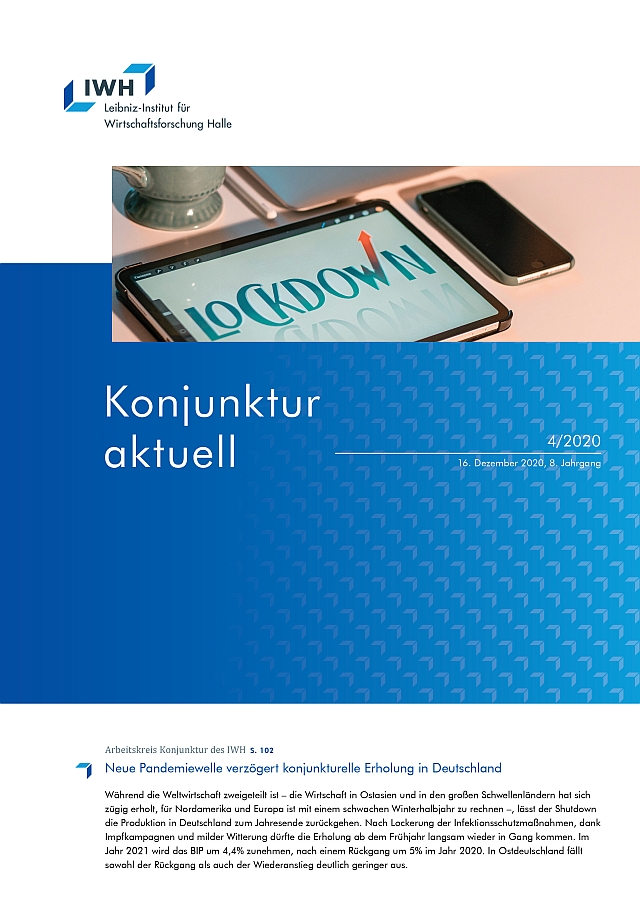High public deficits not only due to the pandemic – Medium-term options for fiscal policy
According to the IWH medium-term projection, Germany's gross domestic product (GDP) will grow by an average of ½% in price-adjusted terms in the years up to 2025, which is one percentage point slower than in the period from 2013 to 2019. This is mainly due to the slump in 2020, but also to the fact that the labour force will decline noticeably. Nominal gross domestic product will probably increase by an average of 2½%. In 2021, the deficit of the general government is likely to amount to 4.3% in relation to gross domestic product due to the pandemic. In the following years, the slower expansion of government revenues, together with the expansion in social spending already laid out before the Corona pandemic, will lead to structural general government deficits of around 2%. If the structural deficit is to be brought back to the reference value of 0.5% in relation to gross domestic product specified in the European Fiscal Compact, consolidation measures are necessary. The IWH's fiscal policy simulation model shows that such a consolidation entails noticeable economic losses in the short term. Consolidation on the expenditure side would reduce production by less than consolidation on the revenue side, not least because it avoids tax hikes that are disincentives to the labour supply.
There are good arguments for not abolishing the debt brake, but for loosening it to some extent. Future generations might even benefit from an expansion of public debt. Of course, more debt entails interest and redemption obligations for the future, but it should be borne in mind that parts of the new debt are likely to be sold to domestic agents, meaning that future debt service will not only be a burden to domestic tax payers, but also a benefit to domestic creditors. It is true that new debt can hinder capital formation, for example if government borrowing crowds out private investment via an increase in interest rates and if receipts are primarily spent on consumption. At present, however, capital market yields have remained very low despite the massive increase in public financing needs. Moreover, the number of highly profitable additional public expenditures is at present likely to be high, for example in the areas of education, digitalisation and green energy. The debt brake should not be abolished but relaxed to the extent permitted by the European Fiscal Compact. This allows structural deficits of 0.5% in relation to gross domestic product.
Long version (in German):
Andrej Drygalla, Katja Heinisch, Oliver Holtemöller, Axel Lindner, Matthias Wieschemeyer, Götz Zeddies: High public deficit not only because of Corona – Medium-term options for action for the state, in: Konjunktur aktuell, Jg. 8 (4), 2020. Halle (Saale) 2020, 150 ff.
Whom to contact
For Researchers

Vice President Department Head
If you have any further questions please contact me.
+49 345 7753-800 Request per E-MailFor Journalists

Head of Public Relations
If you have any further questions please contact me.
+49 345 7753-720 Request per E-MailIWH list of experts
The IWH list of experts provides an overview of IWH research topics and the researchers and scientists in these areas. The relevant experts for the topics listed there can be reached for questions as usual through the IWH Press Office.
Related Publications

High public deficit not only because of Corona - Medium-term options for action for the state
in: Konjunktur aktuell, 4, 2020
Abstract
According to the IWH's medium-term projection, Germany's gross domestic product will grow by an average of ½% in price-adjusted terms in the years to 2025, which is 1 percentage point slower than in the period from 2013 to 2019. This is due not only to the sharp slump in 2020, but also to the fact that the labour force will decline noticeably. Government revenues will be expanding much more slowly than in previous years. Even after the pandemic crisis is overcome, the state budget is likely to have a structural deficit of about 2% relative to GDP if the legal framework remains unchanged, and the debt brake will continue to be violated. Consolidation measures to reduce this deficit ratio to ½ % would push production in Germany below the normal rate of capacity utilization. Simulations with the IWH fiscal policy model show that consolidation on the expenditure side would reduce production by less than consolidation on the revenue side. There is much to be said, also from a theoretical point of view, for not abolishing the debt brake, but for relaxing it to some extent.



